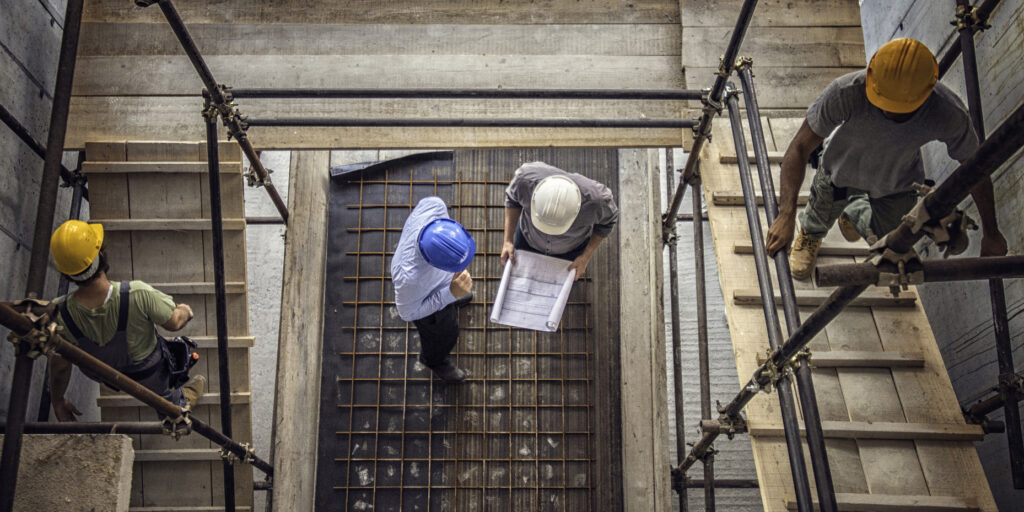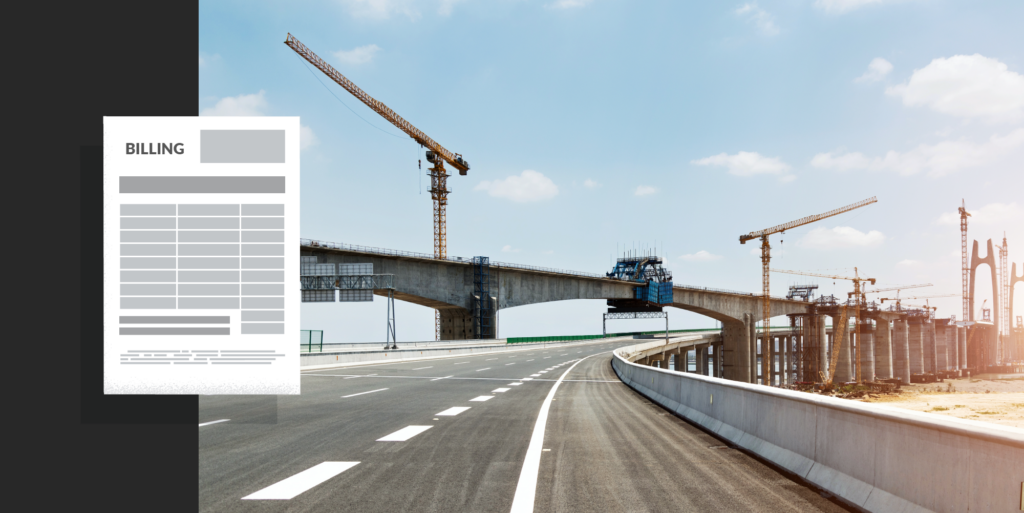— 8 min read
8 Key Construction KPIs for Measuring Success
Last Updated Feb 12, 2025
Last Updated Feb 12, 2025

In construction, using key performance indicators (KPIs) is an excellent way to measure how a project is performing. Managing a construction project — especially a large, complex project — involves so many factors that it can be difficult to track them all.
That’s where KPIs come in: You can focus on just a few valuable metrics that give you a clear picture of how a project — and how your business — is doing.
In this article, we’ll show you eight construction KPIs that will give you a better way to measure success.
Table of contents
What are KPIs?
Key performance indicators (KPIs) measure how well a business is doing compared to its objectives. Each construction company may choose to track different KPIs, but the most common KPIs in construction revolve around financial targets, like cost, cash flow, and profit.
By distilling their focus down to a few key metrics, construction companies can optimize processes and projects to keep their finances on track.
1. Profit
Ultimately, construction businesses exist to make a profit, which they can reinvest in themselves to take on new jobs and expand their operations. Gross profit margin and net profit margin are important KPIs for every construction company.
Gross profit margin
Gross profit margin (also called gross margin ratio) is the amount of money a company makes when cost of goods sold (equipment, labor, and materials) is subtracted from sales. It is expressed as a percentage of sales.
Gross profit margin = (Sales – COGS) ÷ Sales
A higher gross profit margin means a business is making more money on its projects. It does not include administrative and overhead expenses. Construction company owners and CFOs will want to track this KPI closely and share the information with project managers and estimators.
Net profit margin
Net profit margin is the amount of money a company makes when operating costs and cost of goods sold are subtracted from sales. It is also expressed as a percentage of sales. The percentage reflects how much of each dollar earned is actual profit.
Net profit margin = (Sales – COGS – Operating costs – Interest – Taxes) ÷ Sales
A higher net profit margin means a company is making more money overall. If a contractor or supplier is continually experiencing a low net profit margin, they may need to raise prices.
Courses about construction.
For construction.
Unlock your career potential with our free educational courses on Health & Safety, Data in Construction, and more.
2. Cash flow
A construction business depends on cash flow in order to take on new jobs. Even if a construction business is ultimately profitable, they may not have cash on hand to cover project costs while waiting for payment from previous jobs. Successful construction businesses will monitor two key cash flow KPIs: net cash flow and projected cash flow.
Net cash flow
Net cash flow is a measurement of how much money is moving through a business during a specific period of time. To calculate it, take the amount of money that comes into the business during a given period and subtract the amount that went out during that same time period.
Net cash flow = Cash in (given period) – Cash out (given period)
Positive net cash flow amounts mean the company is bringing in more than it spends. Negative net cash flow means that a business is spending more cash than it brings in. Businesses with negative cash flow may be struggling with accounts receivable and in need of more robust collection activities.
Negative net cash flow amounts are not always bad, if the company has savings or additional cash resources to tap. A construction company might also see negative cash flow in the early periods of aggressive growth, before their marketing or business development activities start to pay off.
Projected cash flow
Projected cash flow is a forward-looking view of money that will enter and leave a business over the next several months or years.
Businesses use cash flow projection reports to help analyze cash flows over many periods to get a better understanding of what to expect in the future.
3. Cost variance
Cost variance (CV) is the difference between the actual cost of a project and the planned budget. This can be analyzed at any time during a project by taking the percentage of completion and multiplying it by the planned budget, then subtracting costs to date.
Cost variance = (Planned budget * Percentage of completion) – Actual cost
General contractors may want to break a project down into its scopes to see the project progress by-subcontractor. If any project or item is over budget, it is good to analyze that item and find out why it went over.
Construction estimators and project managers can use a project’s cost variance as a learning opportunity.
4. Working capital
Working capital is a measurement of a company’s ability to pay short-term financial obligations. This particular type of capital is calculated by subtracting current liabilities from current assets.
Working capital = Current assets – Current liabilities
Current assets include cash in the bank and accounts receivable. Liabilities include accounts payable and short-term loans. In general, the higher the working capital number, the better the company’s financial health.
If a contractor has negative working capital, it means they don’t have enough money on hand to pay their current bills. A construction business with negative working capital needs to get its hands on cash as soon as possible. Contractor financing can help provide short-term capital to construction businesses to keep their finances afloat.
5. Accounts payable and receivable turnover
It’s important to measure the turnover for both accounts receivable and accounts payable to see how quickly a business is getting paid by its customers as well as whether they are paying their vendors on time.
Accounts receivable
Accounts receivable turnover (or AR turnover) shows many times pay applications or invoices are paid in full by customers during a given period.
The period is determined by the number of sales used in the calculation and the beginning and ending AR balances that are chosen. The higher your AR turnover, the quicker you are collecting your money.
Accounts receivable turnover= Net sales on credit / [(Beginning AR balance + Ending AR balance) ÷ 2]
Slow payment is common in the construction industry, so keeping a close eye on AR turnover helps construction businesses prevent a much bigger payment problem.
Accounts payable
Accounts payable turnover (or AP turnover) shows how many times in a period the company is paying its outstanding bills. The period is determined by the number of purchases used in the calculation and the beginning and ending AP balances that you choose.
Accounts payable turnover = Total purchases / [(Beginning AP balance + Ending AP balance) ÷ 2]
The more AP turnover a contractor has, the quicker they pay their bills. If accounts payable are delayed, it could mean additional interest charges or other penalties. Improving AP turnover can help construction companies cut costs.
6. Quick ratio
A quick ratio (often just called a “quick”) shows a company’s ability to pay short-term liabilities. The more assets and fewer liabilities a company has, the better the quick ratio. Ratios of 1.5 to 3 are generally considered good, as is stability over time.
Quick ratio = (Current assets – Inventory) ÷ Current liabilities
A construction company’s “quick” is often used by banks and financial institutions to gauge a construction company’s ability to repay a loan.
Stay updated on what’s happening in construction.
Subscribe to Blueprint, Procore’s free construction newsletter, to get content from industry experts delivered straight to your inbox.

7. Planned hours vs. actual
For contractors providing labor on a project, it is recommended that businesses compare budgeted hours with actual hours once a project (or a substantial portion of a project) is complete. There’s nothing to calculate here, as this is a simple comparison. But it’s important that you keep good records to compare budgeted hours with your actual hours on the job.
If actual hours are higher on a project than planned, labor costs could be cutting into the profit margin. Businesses will want to learn from this discrepancy to make a more accurate bid for their future projects.
8. Percentage of labor downtime
Percentage of labor downtime helps businesses calculate productivity on a construction project. Ideally, this number will be as close to 0 as possible, which means field staff are working 100% of the time. Of course, no labor force is constantly working, but aiming for maximum productivity is important.
Percentage of Labor Downtime = Downtime hours / Total hours
It is important to measure the efficiency of workers when they are providing labor for a project. But downtime hours can be difficult to document: No one wants to admit that they weren’t being productive.
Ask workers to be as honest as possible about their productivity (without repercussions), as it will help the company improve its overall effectiveness.
Find the KPIs that matter to your construction business
KPIs can help contractors learn more about their business health. Depending on your priorities figure out ways to be more profitable and efficient, even in uncertain times. When you review your KPIs over time, they offer insight into what trends to expect in the future and how well your construction business handles adversity.
Understanding your business performance is especially critical during — or heading into — a recession. Having a good sense of your KPIs can help you put your construction company through a stress test, to ensure you are prepared for a potential downturn.
The key is to pick just a few KPIs to start, so the information isn’t overwhelming. Get to know those indicators and what they mean before adding more. Be creative and find the KPIs that are important to your construction business — and your bottom line.
Was this article helpful?
Thank you for your submission.
88%
13%
You voted that this article was . Was this a mistake? If so, change your vote here.
Scroll less, learn more about construction.
Subscribe to The Blueprint, Procore’s construction newsletter, to get content from industry experts delivered straight to your inbox.
By clicking this button, you agree to our Privacy Notice and Terms of Service.
Categories:
Tags:
Written by
Dawn Killough
34 articles
Dawn Killough is a writer with over 20 years of experience in construction, having worked as a staff accountant, green building advisor, project assistant, and contract administrator. She holds a BA in Psychology and MS in Conflict Resolution, both from the University of Portland. She shares fundamental green building strategies and techniques in her book, Green Building Design 101. Dawn lives in Portland, Oregon.
View profileExplore more helpful resources

Construction Collaboration: Navigating the Intersection of Project Management and Accounting
Accounting and project teams work together to move the financial aspects of projects through to completion. Data sharing allows for concurrent review to make this possible. Teams need to share...

What are Committed Costs in Construction Accounting?
In construction projects, managing finances can be a challenging task — but understanding committed costs can simplify the process. Committed costs refer to expenses that are guaranteed through formal agreements,...

Understanding Construction Financial Statements
For construction firms, effectively managing financial statements is an important building block for success. These documents play a key role in tracking performance, maintaining financial health and securing future projects....

Construction Progress Billing: Keeping the Cash Flowing
Rome wasn’t built in a day, and neither are skyscrapers and bridges. Construction projects take time, and because of that, they require significant upfront costs for labor, materials and equipment....